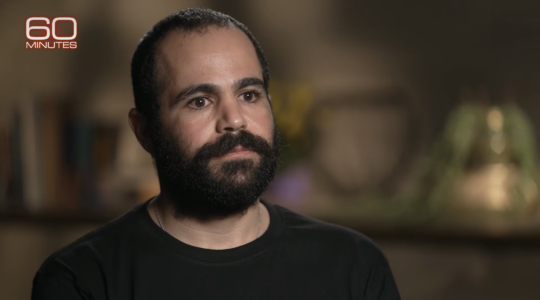
Members of an aliyah group from the Hashomer Hatzair youth movement from Toronto, Montreal and Detroit at a summer camp in 1949, not long before many of them would immigrate to Israel. (Courtesy of Ted Friedgut)

Alumni of the Hashomer Hatzair youh movement revel in some Israeli dancing at a reunion at the end of an oneg Shabbat — their custom for the past 65 years, October 2010. (Ted Friedgut)
KIBBUTZ GALON, Israel (JTA) – In 1952, a 20-year-old with bright blue eyes who had never seen much of life outside of the Bronx, N.Y., mounted a kibbutz tractor armed with a rifle to plow wheat and sorghum fields bordering the Gaza Strip.
Saul Adelson would live in Israel for eight years before returning to the United States for good.
“I don’t regret a minute of my time here, but events took my life back to the States,” Adelson said last week as he walked down a rock-strewn path on Kibbutz Galon, which he first visited in his youth. Back then it wasn’t much more than a collection of sheds and spindly trees on a windswept hill.
Two of his closest friends with whom he grew up in the socialist Zionist movement Hashomer Hatzair, and with whom he immigrated to Israel, still live on the kibbutz. Last week they came together there along with some 100 others, including spouses, for a 60th reunion of their North American aliyah group, called Garin Aliyah Zion. Garin is Hebrew for seed.
“It was an extraordinary period, right after World War II, and American Jews were waking up to the reality of the Holocaust,” said Yitzhak Greenfield, 78, who lost relatives to the Nazis.
In Hashomer Hatzair, he said, “we were educated for aliyah.” Not just any aliyah: They were specifically indoctrinated with the message that life in the kibbutz was the only way to synthesize the socialist and Zionist visions of the movement.
Members met at movement meetings in places like Montreal, Los Angeles, Chicago and the Bronx, where Yudi Tishler, 77, recalls movement gatherings being held in a bare attic with only a couple of Israeli flags for decoration.
For those that agreed to make the leap to Israel, their first stop en route was an agricultural training farm in Hightstown, N.J. Several months later — after learning how to milk cows and grow vegetables — these American Jewish teenagers were off to encounter the real thing in Israel.
They left behind often-devastated parents, many of whom were themselves immigrants from Europe who could not fathom their children leaving the comforts of North America, for which they had worked so hard, in exchange for a hardscrabble life in the newly established Jewish state.
To get here, they traveled on freighter ships across the Atlantic before crossing the Mediterranean and docking in Haifa.
“There was an atmosphere then when we arrived in the country — a spirit of young life with a purpose that has remained with us our whole lives,” said Ariel Hurwitz, 78, one of Adelson’s good friends.
Soon after Hurwitz arrived in Israel six decades ago, this kibbutz in the foothills of the Judean mountain range has been his home.
The lives of the group’s members — or “chaverim,” as they still refer to each other — took divergent paths. Of the more than 100 members of the Hashomer Hatzair group who made aliyah, approximately half remain in Israel today.
While Hurwitz was working in the kibbutz cow sheds and serving in a paratrooper unit of the nascent Israeli army — he still has the shrapnel wounds he suffered in 1955 during an Egyptian bombardment of the southern border — Adelson was back in New York, where he eventually started a career in architecture.
Still, the bonds among members have remained remarkably close.
A group of five families from the group who live in the Washington area have been meeting for a Shabbat meal every month for the past 35 years.
“We were together for five years 65 years ago, so what keeps us so close? It’s a feeling more intense than that of being fellow alumnae of a school,” said Hurwitz, who helped organize the reunion. “It’s the values we developed in the movement both in regards to Judaism and humanitarian principles. Wherever we are today, we are all involved in Jewish life and our communities.”
Hurwitz eventually became a teacher, earning a doctorate in Jewish history. Many in the group went on to gain prominence: Among those attending the reunion were a New York state lawmaker, scientists and professors.
Dina Feur, who was in the aliyah group but also moved back to the States, said her experience made her a lifelong Zionist — and visitor to Israel.
“It tied us to Judaism and to Israel. We came back here all the time,” Feur said.
She had joined the movement as an 11-year-old girl in Brooklyn. Like the others, she would wear the movement’s blue bandana wrapped around her shirt collar to meetings.
Today Feur has bobbed gray hair and rimless glasses. With her husband, she lived in Israel for 11 years before returning to study in the United States. It was supposed to be for five years, but it turned into the rest of their lives when her husband could not find work in Israel as a geologist. They have a son and grandchildren living in Israel.
When he first arrived in Israel, Greenberg, a painter, remembers riding a truck along the dusty unpaved roads to Kibbutz Galon, where he lived for several years before eventually settling in Ein Karem, outside of Jerusalem.
“It was wonderful because I knew we were starting a new life,” he said. “We were building a new world.”
The demands of a difficult, intensely communal and doctrinaire ideology eventually drove many of them away, sometimes straining relations for years between members who stayed on kibbutz and those who left.
Tishler, a musician who had left Kibbutz Galon and another Hashomer Hatzair kibbutz soon afterward, still smarts at the memory of her kibbutz friends not contacting her to send condolences after her first husband died. She was pregnant with twins at the time.
“You were totally ostracized when you left the kibbutz,” said Tishler, who eventually remarried and settled in New York. She became a musicology professor at the Jewish Theological Seminary before returning to live in Israel in her retirement, joining her twin daughters who had made aliyah.
As the ideological fervor of the early years waned, connections and friendships were re-established. Now, over slices at the Kibbutz Galon pizzeria, the gray-haired chaverim looked back on a changed world.
“It was the right decision and the right time in my life,” said Greenfield, who came to Israel at 19 and never left. “I felt like I could do all sorts of things in America, but I preferred to do them here.”
JTA has documented Jewish history in real-time for over a century. Keep our journalism strong by joining us in supporting independent, award-winning reporting.





